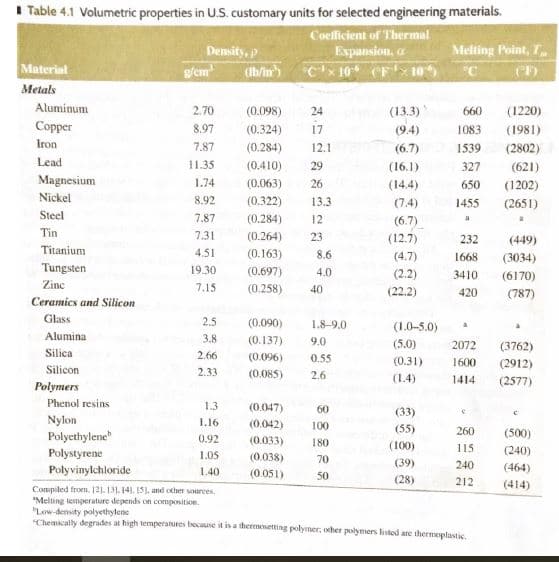M4.17 Asteel shaft has a starting diameter= 15.00 mm. It is to be inserted into a hole in an expansion fit assembly operation. To be readily inserted, the shaft must be reduced in diameter by cooling Determine the temperature to which the shaft must be reduced from room temperature (20°C) in order to reduce its diameter to 14.98 mm. Use Table 4.1 from the book for reference. Round to the nearest 10th of a C Table 4.1 Volumetric properties in U.S. customary units for selected engineering materials Coclicient of Thermal Expansion, a Cx10F10 Melting Point, T Density, p g/em Material Metals Aluminum 2.70 (0.098) (13.3) 660 (1220) 24 Copper 8.97 (0.324) 17 1083 (1981) (94) Iron 7.87 (0.284) 12.1 (6.7) 1539 (2802) Lead 11.35 (0.410) 29 (621) (16.1) 327 Magnesium 1.74 (0.063) 26 (144) 650 (1202) Nickel 8.92 (0.322) 13.3 (7.4) (2651) 1455 Steel (0.284) 7.87 12 (6.7) a Tin 7.3 (0.264) 23 (12.7) 232 (449) Titanium 4.51 (0.163) 8.6 (4.7) 1668 (3034) Tungsten 19.30 (0.697) 4.0 (2.2) 3410 (6170) Zinc 7.15 (0.258) 40 (22.2) 420 (787) Ceramics and Silicon Glass 2.5 (0.090) 1.8-9.0 (1.0-5.0) Alumina 3.8 (0.137) 9.0 (5.0) 2072 (3762) Silica 2.66 (0.096) 0.55 (0.31) 1600 (2912) Silicon 2.33 (0.085) 2.6 (1.4) 1414 (2577) Polymers Phenol resins 1.3 (0.047) 60 (33) Nylon Polyethylene I.16 (0042) 100 (55) 260 (500) 0.92 (0.033) 180 (100) 115 (240) Polystyrene 1.05 (0.038) 70 (39) 240 (464) Polyvinylchloride 140 (0.051) 50 (28) 212 (414) Compiled from. 121.131. 141. 15). and other sources Melting tesmperature depends on composition Low-density polyethylene Chemically degrades at high temperanures because it is a thermosetting polymer, ocher polymers listed are thermoplastic
M4.17 Asteel shaft has a starting diameter= 15.00 mm. It is to be inserted into a hole in an expansion fit assembly operation. To be readily inserted, the shaft must be reduced in diameter by cooling Determine the temperature to which the shaft must be reduced from room temperature (20°C) in order to reduce its diameter to 14.98 mm. Use Table 4.1 from the book for reference. Round to the nearest 10th of a C Table 4.1 Volumetric properties in U.S. customary units for selected engineering materials Coclicient of Thermal Expansion, a Cx10F10 Melting Point, T Density, p g/em Material Metals Aluminum 2.70 (0.098) (13.3) 660 (1220) 24 Copper 8.97 (0.324) 17 1083 (1981) (94) Iron 7.87 (0.284) 12.1 (6.7) 1539 (2802) Lead 11.35 (0.410) 29 (621) (16.1) 327 Magnesium 1.74 (0.063) 26 (144) 650 (1202) Nickel 8.92 (0.322) 13.3 (7.4) (2651) 1455 Steel (0.284) 7.87 12 (6.7) a Tin 7.3 (0.264) 23 (12.7) 232 (449) Titanium 4.51 (0.163) 8.6 (4.7) 1668 (3034) Tungsten 19.30 (0.697) 4.0 (2.2) 3410 (6170) Zinc 7.15 (0.258) 40 (22.2) 420 (787) Ceramics and Silicon Glass 2.5 (0.090) 1.8-9.0 (1.0-5.0) Alumina 3.8 (0.137) 9.0 (5.0) 2072 (3762) Silica 2.66 (0.096) 0.55 (0.31) 1600 (2912) Silicon 2.33 (0.085) 2.6 (1.4) 1414 (2577) Polymers Phenol resins 1.3 (0.047) 60 (33) Nylon Polyethylene I.16 (0042) 100 (55) 260 (500) 0.92 (0.033) 180 (100) 115 (240) Polystyrene 1.05 (0.038) 70 (39) 240 (464) Polyvinylchloride 140 (0.051) 50 (28) 212 (414) Compiled from. 121.131. 141. 15). and other sources Melting tesmperature depends on composition Low-density polyethylene Chemically degrades at high temperanures because it is a thermosetting polymer, ocher polymers listed are thermoplastic
Principles of Heat Transfer (Activate Learning with these NEW titles from Engineering!)
8th Edition
ISBN:9781305387102
Author:Kreith, Frank; Manglik, Raj M.
Publisher:Kreith, Frank; Manglik, Raj M.
Chapter6: Forced Convection Over Exterior Surfaces
Section: Chapter Questions
Problem 6.10P
Related questions
Question

Transcribed Image Text:M4.17 Asteel shaft has a starting diameter= 15.00 mm. It is to be inserted into a hole in an expansion
fit assembly operation. To be readily inserted, the shaft must be reduced in diameter by cooling
Determine the temperature to which the shaft must be reduced from room temperature (20°C) in
order to reduce its diameter to 14.98 mm. Use Table 4.1 from the book for reference. Round to the
nearest 10th of a C

Transcribed Image Text:Table 4.1 Volumetric properties in U.S. customary units for selected engineering materials
Coclicient of Thermal
Expansion, a
Cx10F10
Melting Point, T
Density, p
g/em
Material
Metals
Aluminum
2.70
(0.098)
(13.3)
660
(1220)
24
Copper
8.97
(0.324)
17
1083
(1981)
(94)
Iron
7.87
(0.284)
12.1
(6.7)
1539
(2802)
Lead
11.35
(0.410)
29
(621)
(16.1)
327
Magnesium
1.74
(0.063)
26
(144)
650
(1202)
Nickel
8.92
(0.322)
13.3
(7.4)
(2651)
1455
Steel
(0.284)
7.87
12
(6.7)
a
Tin
7.3
(0.264)
23
(12.7)
232
(449)
Titanium
4.51
(0.163)
8.6
(4.7)
1668
(3034)
Tungsten
19.30
(0.697)
4.0
(2.2)
3410
(6170)
Zinc
7.15
(0.258)
40
(22.2)
420
(787)
Ceramics and Silicon
Glass
2.5
(0.090)
1.8-9.0
(1.0-5.0)
Alumina
3.8
(0.137)
9.0
(5.0)
2072
(3762)
Silica
2.66
(0.096)
0.55
(0.31)
1600
(2912)
Silicon
2.33
(0.085)
2.6
(1.4)
1414
(2577)
Polymers
Phenol resins
1.3
(0.047)
60
(33)
Nylon
Polyethylene
I.16
(0042)
100
(55)
260
(500)
0.92
(0.033)
180
(100)
115
(240)
Polystyrene
1.05
(0.038)
70
(39)
240
(464)
Polyvinylchloride
140
(0.051)
50
(28)
212
(414)
Compiled from. 121.131. 141. 15). and other sources
Melting tesmperature depends on composition
Low-density polyethylene
Chemically degrades at high temperanures because it is a thermosetting polymer, ocher polymers listed are thermoplastic
Expert Solution
This question has been solved!
Explore an expertly crafted, step-by-step solution for a thorough understanding of key concepts.
This is a popular solution!
Trending now
This is a popular solution!
Step by step
Solved in 2 steps with 2 images

Recommended textbooks for you

Principles of Heat Transfer (Activate Learning wi…
Mechanical Engineering
ISBN:
9781305387102
Author:
Kreith, Frank; Manglik, Raj M.
Publisher:
Cengage Learning

Principles of Heat Transfer (Activate Learning wi…
Mechanical Engineering
ISBN:
9781305387102
Author:
Kreith, Frank; Manglik, Raj M.
Publisher:
Cengage Learning